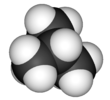
Back إيزوبوتان Arabic Metilpropà Catalan Isobutan Czech Isobutan Danish Isobutan German Μεθυλοπροπάνιο Greek Izobutano Esperanto Metilpropano Spanish Isobutaan Estonian Isobutano Basque
| |||
| |||
| Names | |||
|---|---|---|---|
| Preferred IUPAC name
2-Methylpropane[1] | |||
Other names
| |||
| Identifiers | |||
3D model (JSmol)
|
|||
| 1730720 | |||
| ChEBI | |||
| ChemSpider | |||
| ECHA InfoCard | 100.000.780 | ||
| EC Number |
| ||
| E number | E943b (glazing agents, ...) | ||
| 1301 | |||
| KEGG | |||
PubChem CID
|
|||
| RTECS number |
| ||
| UNII | |||
| UN number | 1969 | ||
CompTox Dashboard (EPA)
|
|||
| |||
| |||
| Properties | |||
| C4H10 | |||
| Molar mass | 58.124 g·mol−1 | ||
| Appearance | Colorless gas | ||
| Odor | Odorless | ||
| Density |
| ||
| Melting point | −159.42 °C (−254.96 °F; 113.73 K)[4] | ||
| Boiling point | −11.7 °C (10.9 °F; 261.4 K)[4] | ||
| 48.9 mg⋅L−1 (at 25 °C (77 °F))[2] | |||
| Vapor pressure | 3.1 atm (310 kPa) (at 21 °C (294 K; 70 °F))[3] | ||
Henry's law
constant (kH) |
8.6 nmol⋅Pa−1⋅kg−1 | ||
| Conjugate acid | Isobutanium | ||
| −51.7·10−6 cm3/mol | |||
| Thermochemistry | |||
Heat capacity (C)
|
96.65 J⋅K−1⋅mol−1 | ||
Std enthalpy of
formation (ΔfH⦵298) |
−134.8 – −133.6 kJ⋅mol−1 | ||
Std enthalpy of
combustion (ΔcH⦵298) |
−2.86959 – −2.86841 MJ⋅mol−1 | ||
| Hazards | |||
| GHS labelling: | |||

| |||
| Danger | |||
| H220 | |||
| P210 | |||
| NFPA 704 (fire diamond) | |||
| Flash point | −83 °C (−117 °F; 190 K) | ||
| 460 °C (860 °F; 733 K) | |||
| Explosive limits | 1.4–8.3% | ||
| NIOSH (US health exposure limits): | |||
PEL (Permissible)
|
None[5] | ||
REL (Recommended)
|
TWA 800 ppm (1900 mg/m3)[5] | ||
IDLH (Immediate danger)
|
N.D.[5] | ||
| Safety data sheet (SDS) | lindeus.com | ||
| Related compounds | |||
Related alkane
|
Isopentane | ||
| Supplementary data page | |||
| Isobutane (data page) | |||
Except where otherwise noted, data are given for materials in their standard state (at 25 °C [77 °F], 100 kPa).
| |||
Isobutane, also known as i-butane, 2-methylpropane or methylpropane, is a chemical compound with molecular formula HC(CH3)3. It is an isomer of butane. Isobutane is a colorless, odorless gas. It is the simplest alkane with a tertiary carbon atom. Isobutane is used as a precursor molecule in the petrochemical industry, for example in the synthesis of isooctane.[6]
- ^ Nomenclature of Organic Chemistry : IUPAC Recommendations and Preferred Names 2013 (Blue Book). Cambridge: The Royal Society of Chemistry. 2014. p. 652. doi:10.1039/9781849733069-FP001. ISBN 978-0-85404-182-4.
The names 'isobutane', 'isopentane', and 'neopentane' are no longer recommended.
- ^ "Solubility in Water". PubChem. National Center for Biotechnology Information. Retrieved 6 April 2017.
- ^ "CDC - NIOSH Pocket Guide to Chemical Hazards - Isobutane". CDC - NIOSH Pocket Guide to Chemical Hazards. CDC. Retrieved 28 December 2018.
- ^ a b Record in the GESTIS Substance Database of the Institute for Occupational Safety and Health
- ^ a b c NIOSH Pocket Guide to Chemical Hazards. "#0350". National Institute for Occupational Safety and Health (NIOSH).
- ^ "Patent Watch, July 31, 2006". Archived from the original on March 11, 2007. Retrieved August 8, 2006.
© MMXXIII Rich X Search. We shall prevail. All rights reserved. Rich X Search




